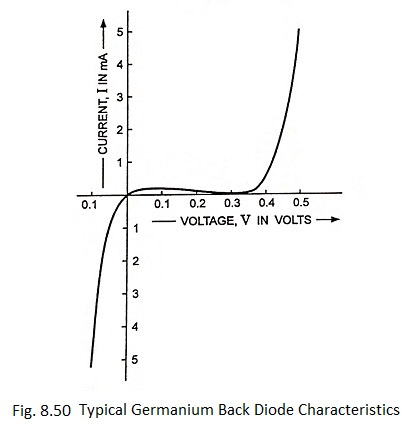What is Backward Diode?
A tunnel diode designed to provide a small peak current (IP of the order of IV) may be employed to advantage in the reverse direction, for purposes for which the conventional diode is used in the forward direction. Because this device is a better conductor in the reverse direction than in the forward direction, it is also called a backward diode or simply a back diode.
The diode has the same reverse characteristic as the tunnel diode but the forward characteristic as depicted in Fig. 8.50. In the neighborhood of zero voltage, in response to either a forward biasing or reverse biasing voltage, the tunnel diode responds with a current which is large in comparison with the corresponding current in a conventional diode. Such large currents are due to tunneling effect. In the back diode, the current due to tunneling effect is large only in the reverse direction. That is why, the back diode is also called a unilateral diode. The high conduction portion of V-I characteristic depicted in Fig. 8.50 is in the third quadrant. As this portion of the characteristic corresponds to the region of forward conduction in a conventional diode, it is customary to plot the back diode with the voltage and current scales both reversed.
Advantages:
The advantages of the back diode are that the temperature sensitivity of the back diode is appreciably less than the sensitivity of the conventional diode. The back diode has a sensitivity of about -0.1 mV/°C for both germanium and silicon diodes while a conventional diode has a sensitivity of about -2 mV/°C. It has a breakpoint at 0 V whereas the conventional diode has a break point, at room temperature, between 0.6 and 0.7 V. So the back diode is very useful when the rectifying action of a diode is required in connection with small amplitude waveforms. With a back diode the efficiency is greatly improved, has a good frequency response, low noise level.
Applications:
Backward diodes have wide applications as low-level mixer in Doppler radar, video detector etc.
